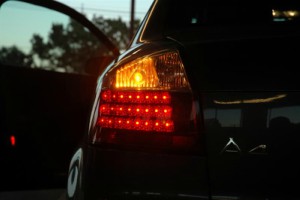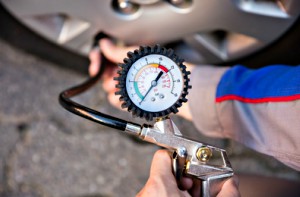An MOT as we know it is for all cars that are more than three years old. In the UK, it tests cars of their roadworthiness, in other words, how safe it is to drive on the roads.
We’ve found that most cars fail their test, due to common faults each time according to data taken from the Driver and Vehicle Standards Authority (the DVSA – the body that oversees the MOT) and we have reviewed what the most common MOT failures are.
Here are some examples of the common failures and some advice on how you can potentially avoid them.
We’ve found that most cars fail their test, due to common faults each time according to data taken from the Driver and Vehicle Standards Authority (the DVSA – the body that oversees the MOT) and we have reviewed what the most common MOT failures are.
Here are some examples of the common failures and some advice on how you can potentially avoid them.
 Lighting and signalling (18.9%)
Lighting and signalling (18.9%)It has been found that approximately a fifth of all cars that fail their MOT is because of an issue with their lights, this is often as simple as a blown bulb.
To avoid this fault?
Switch all your lights on and walk around your car to check they’re in working order. Bearing in mind, all-important lights like your indicators – do they flash as they should?
Suspension (13%)
Data found that the RAC attended over 6,500 breakdowns caused because of potholes in the first quarter of 2017 – therefore, it’s not a big shock to find that more than one in ten MOT failures are caused by suspension issues.
This particular fault can be fairly well hidden, due to either a missing leaky shock absorber or just a snapped spring.
To avoid this fault?
Pay attention to noises made by your car during every day driving – especially when going around corners or passing over bumpy roads. Also, if they are any strange ‘clunks’, it is best to park up and spend a few moments checking your car. Look at whether it is too high or too low in areas. A simple test can be conducted by yourself, just by pushing down on each corner – does it return to its normal level when you let go without ‘bouncing’ up and down.
Brakes (10%)
It was discovered that one in ten cars fail their MOT due to issues with their braking system.
The problems to look for are squealing or grinding noises from your brakes, this is a sign to show that your pads are running low. Also, when you are coming to a stop – does it stop in a straight line or does it pull to one side?
Manually, you can inspect your discs and pads – this can be done by removing the wheel. Here’s a short video on how you’d go about this procedure – simply click here. Another way is by just looking through the spokes.
When inspecting the two components, look out for whether the surface of the brake disc is smooth or how thick the brake pads are.
Checking your handbrake is also a key component to remember to test as well, to do this you stop your car on a hill and apply the handbrake. Does the car hold position? If not, this shows it needs adjusting.
Data found that the RAC attended over 6,500 breakdowns caused because of potholes in the first quarter of 2017 – therefore, it’s not a big shock to find that more than one in ten MOT failures are caused by suspension issues.
This particular fault can be fairly well hidden, due to either a missing leaky shock absorber or just a snapped spring.
To avoid this fault?
Pay attention to noises made by your car during every day driving – especially when going around corners or passing over bumpy roads. Also, if they are any strange ‘clunks’, it is best to park up and spend a few moments checking your car. Look at whether it is too high or too low in areas. A simple test can be conducted by yourself, just by pushing down on each corner – does it return to its normal level when you let go without ‘bouncing’ up and down.
Brakes (10%)
It was discovered that one in ten cars fail their MOT due to issues with their braking system.
The problems to look for are squealing or grinding noises from your brakes, this is a sign to show that your pads are running low. Also, when you are coming to a stop – does it stop in a straight line or does it pull to one side?
Manually, you can inspect your discs and pads – this can be done by removing the wheel. Here’s a short video on how you’d go about this procedure – simply click here. Another way is by just looking through the spokes.
When inspecting the two components, look out for whether the surface of the brake disc is smooth or how thick the brake pads are.
Checking your handbrake is also a key component to remember to test as well, to do this you stop your car on a hill and apply the handbrake. Does the car hold position? If not, this shows it needs adjusting.
 Tyres (7.7%)
Tyres (7.7%)Checking your tyres regularly are a must! If these four bits of rubber aren’t in top shape, this can lead to major risks when travelling on the roads e.g. loss of grip.
This is the fourth most popular failure rate for the annual test, so check out our tyres guide to ensure you get all the information you need.
To avoid this fault?
Use a 20p coin to check the tread depth! The law states that tyres need 1.6mm of tread across the central three quarters. By inserting the 20p coin – if you can see the outer band, the tread is too low and you could be fined up to £2,500 and hit with three penalty points per tyre! Nobody wants that…
Visually check for lumps or cuts – both of which could cause a dangerous blowout and should be fixed immediately.
It’s also important to not always rely on what you can see, but also by feeling the inside of the tyre, this can indicate issues like uneven wear due to problems with alignment or poor inflation.
Issues affecting the driver’s view of the road (7.2%)
When it comes down to seeing the road clearly, this is obviously a vital to ensure you are safely driving – although an astounding 7.2% of MOT failures are a result of issues affecting the driver’s view of the road.
This can include things blocking the windscreen like an air freshener, or cracks and chips within the driver’s eye line.
To avoid this fault?
Remove all unnecessary objects that are hanging in your car which could interfere with your vision of the roads.
This can include whether the bonnet of your car can be closed securely if it can’t – this could mean there is a danger with your bonnet opening and blocking the view of the driver.
Furthermore, this can extend to the windscreen wipers too. Make sure they are working as they should, we have a quick guide about windscreen wiper maintenance. It’s worth topping up your windscreen washer fluid before the test too.
We hope this guide has given you the confidence of checking over your car and knowing how to notice and fix a fault yourself, before attending the big test!
For more CarCliq guides click here
Use a 20p coin to check the tread depth! The law states that tyres need 1.6mm of tread across the central three quarters. By inserting the 20p coin – if you can see the outer band, the tread is too low and you could be fined up to £2,500 and hit with three penalty points per tyre! Nobody wants that…
Visually check for lumps or cuts – both of which could cause a dangerous blowout and should be fixed immediately.
It’s also important to not always rely on what you can see, but also by feeling the inside of the tyre, this can indicate issues like uneven wear due to problems with alignment or poor inflation.
Issues affecting the driver’s view of the road (7.2%)
When it comes down to seeing the road clearly, this is obviously a vital to ensure you are safely driving – although an astounding 7.2% of MOT failures are a result of issues affecting the driver’s view of the road.
This can include things blocking the windscreen like an air freshener, or cracks and chips within the driver’s eye line.
To avoid this fault?
Remove all unnecessary objects that are hanging in your car which could interfere with your vision of the roads.
This can include whether the bonnet of your car can be closed securely if it can’t – this could mean there is a danger with your bonnet opening and blocking the view of the driver.
Furthermore, this can extend to the windscreen wipers too. Make sure they are working as they should, we have a quick guide about windscreen wiper maintenance. It’s worth topping up your windscreen washer fluid before the test too.
We hope this guide has given you the confidence of checking over your car and knowing how to notice and fix a fault yourself, before attending the big test!
For more CarCliq guides click here